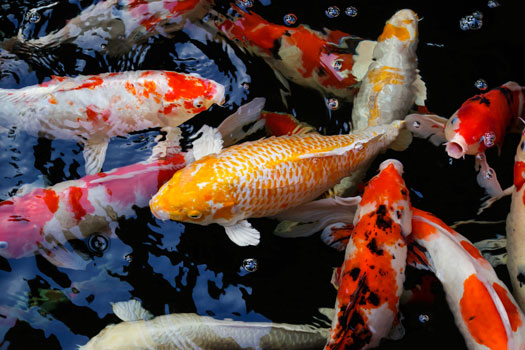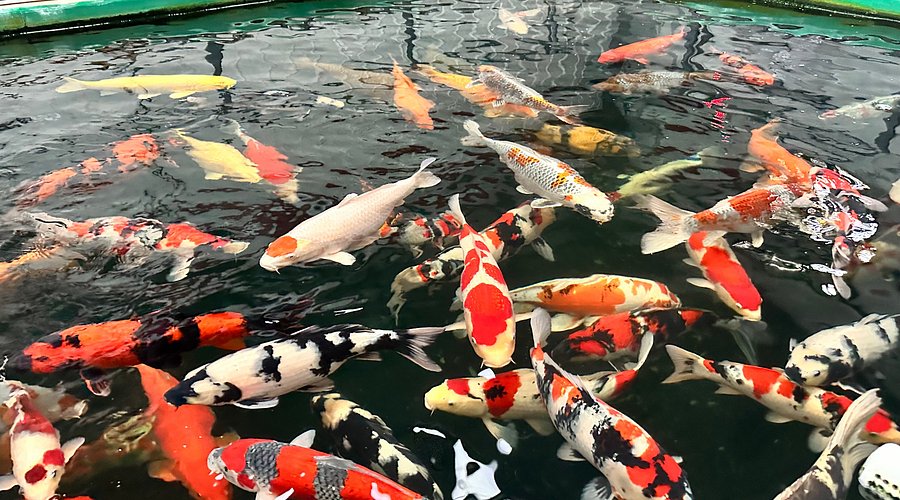Koi 3-4 inch
Koi 3-4 inch
Total items
Product subtotal
Detailed Description
Detailed Description
Koi fish, also known as Nishikigoi in Japanese, are ornamental carp that have been selectively bred for their vibrant colors and patterns. They are highly valued for their beauty and symbolism, particularly in Japanese culture, where they are associated with strength, perseverance, and good fortune. Koi fish are often found in ponds, water gardens, and decorative outdoor settings, where they are admired for their graceful movements and colorful displays.
Physical Characteristics:
Size: Koi are large fish, with some individuals growing to lengths of 24 to 36 inches (60 to 90 cm), and occasionally even larger in optimal conditions. The size of a koi is often determined by the size of the pond or tank in which they live.
Body Shape: Koi fish have a sleek, elongated, and muscular body that tapers towards the tail. They are built for swimming long distances and can live for many years in the right conditions.
Coloration and Patterns: One of the most distinctive features of koi fish is their striking coloration. Koi can come in a wide range of colors, including red, orange, white, yellow, black, and blue, with combinations of these shades creating various patterns. Some of the most common types of Koi include:
Kohaku: White body with red markings.
Sanke: White body with red and black markings.
Showa: Black body with red and white markings.
Utsuri: Black body with red or white markings.
Shiro Utsuri: White body with black markings.
Asagi: Blue or grayish body with red markings.
Bekko: White, yellow, or red body with black markings.
The patterns and colors on a koi's body are part of what makes each individual unique, and koi enthusiasts often seek rare or particularly beautiful specimens.
Fins and Tail: Koi have long, flowing fins and a wide tail that they use to glide gracefully through the water. Their dorsal fins are typically tall and pointed, and their pectoral fins are broad, which gives them excellent maneuverability in the water.
Behavior and Habitat:
Temperament: Koi are generally peaceful and sociable fish, often seen swimming in groups, known as a "school," and interacting with one another. They are not aggressive and can coexist peacefully with other pond fish, such as goldfish or other non-aggressive species. However, larger koi may occasionally compete for food.
Habitat: Koi are freshwater fish, typically kept in outdoor ponds or large tanks. They thrive in spacious environments with good water circulation and filtration. Koi require clean, well-oxygenated water, with a temperature range of 59-77°F (15-25°C). While they are hardy, they are sensitive to water quality and require regular monitoring of pH, ammonia, nitrite, and nitrate levels to ensure their health.
Diet: Koi are omnivorous and will eat a variety of foods, including koi pellets, algae, and small invertebrates. In a pond setting, they will often forage for natural food sources, such as insects, worms, and plants. It's important to feed koi a balanced diet to maintain their vibrant colors and overall health.
Lifespan and Growth:
Koi fish are long-lived, with many living well over 20 years if properly cared for. Some exceptional koi have been known to live for up to 50 years or more. They are slow-growing fish, with young koi reaching adulthood over the course of several years. The largest koi specimens are often considered both a work of art and a symbol of endurance and perseverance.
Care in Ponds:
Proper care is essential to maintaining healthy and vibrant koi. They require:
Adequate pond size: Koi need plenty of space to swim freely. A pond should be at least 1,000 gallons for a small group of koi, with a depth of at least 3 feet to allow for overwintering.
Water quality: Regular water testing and filtration are essential, as koi are sensitive to poor water conditions. Proper filtration helps keep the water clean and free of harmful toxins.
Feeding: Koi should be fed a high-quality koi food that is designed to enhance their growth and coloration. Overfeeding should be avoided to prevent water quality issues.
Winter care: In colder climates, koi may need to be moved to a heated indoor tank or provided with a pond heater to keep the water temperature stable during winter months.
Koi fish are more than just beautiful ornamental creatures—they are symbols of strength, perseverance, and good fortune in many cultures, particularly in Japan. Their graceful movements, vibrant colors, and long lifespans make them a beloved species for pond keepers and aquarium enthusiasts alike. While they require a significant investment in time, space, and care, the rewards of keeping koi are immense. Their beauty, peaceful nature, and the joy they bring to outdoor spaces make them an enduring symbol of tranquility and prosperity. Whether you are a novice or an experienced pond keeper, koi offer both an aesthetic and spiritual connection to nature that is hard to match.
Product features
Product features
Materials and care
Materials and care
Merchandising tips
Merchandising tips
Share




